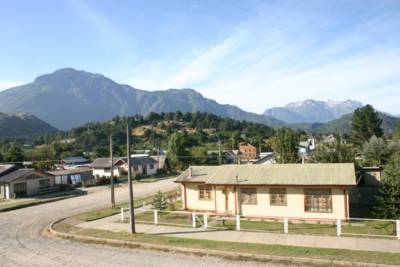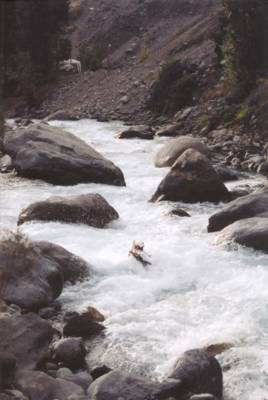
Tyler Brandt and other World Class Academy students spend the afternoon studying the airblunt. Futaleufu's best access playspot, La Pistola - February 2004.

When is the time to kayak the Futa? - usually a phrase pondered by anyone who has heard of and may want to visit the legendary Futaluefu river found in Patagonian Chile. The Futaleufu is found in a region of Chile where the sea is less than 100km away from the country's border with Argentina. Up in the valley the Futaleufu receives heavy precipitation coming in from the coast most of the year, making the river often exceed flows of 30,000 cfs. However in the months of December through March, the summer heat and shifting winds keep the clouds away long enough for summer to prosper as water levels drop and the radiant blue colors of the Futaleufu appear.

Lush riverbanks and jagged peaks surround the Futaleufu valley, Chile.

It is finally this far south on the South American continent where the Andes are low enough that it allows for a river to drain from the opposite side of the mountains in Argentina. Starting from many lakes and small creeks near Esquel, Argentina, the Futaleufu meanders along the dry arid pampa, but soon it turns back to the West. As the Futaleufu crosses into Chile, it enters a magnificent valley surrounded by towering peaks and begins a quick yet thunderous flow down to Lago Yelcho, where the town of Chaiten and the Pacific Ocean are only 50km away. The 3 main sections of river that most paddlers hope to experience include Infierno Canyon to Rio Azul, Rio Azul down to Puente Colgante (which includes Terminator and the Himalayas) and the most non-stop wave action found on the bridge (Peunte Colgante) to next road bridge or further downstream to the Casa de Peidra rapid.

Tom Faucher finds a wave on the Bridge to Bridge section of the Rio Futaleufu, Chile.

Those looking to package the most of Chile into the shortest of paddling vacations can often make a visit to Futaleufu in as little as 10 days thanks to easy flights and routine shuttlebus service up to the town of Futaleufu from the inner coastal town of Chaiten. From other kayaking spots farther north like Pucon, getting to Futa presents a couple of choices. The popular option if you can afford it is to rent a 4 door pick-up in Chile and drive it across the border and head directly south along the scenic eastern slopes of Argentina. There are no connecting roads through Chile unless you use the ferry system and having your own shuttle vehicle in the Futa valley gives you the freedom to paddle and camp whenever, wherever. The only negative is that the car rental price will have an added charge for authorization to cross the borders. Taking the ferry or flying from Puerto Montt to Chaiten is probably the more direct route to Futaleufu if you are alone or without a car.

Summer in the town of Futaleufu, Chile.

If you arrive without a place to stay an excellent choice is to pitch a tent at Campo del Indio, which is one of the few settlements located along the lower bridge to bridge (III-IV) run. Luis Mundaca has farmed here with his family for many generations. From a few meters from your camp near the water's edge, you can put in directly above one of Futaleufu's largest crashing wave, paddle 5km of great rapids, and at the very worst have a quiet walk along the road back up to your tent. Throughout the months of January and February the area usually has a group of paddlers around to run into. On the upper stretches of the Rio Futaleufu you will find larger camps belonging to Bio Bio, Earth River, and Expediciones Chile. Before long the road passes through the quiet village also with the name of Futaleufu, where you can purchase food, other services and accommodation. Click here for a simple map of the Rio Futaleufu's named rapids and features.

Scott Fiendel.



